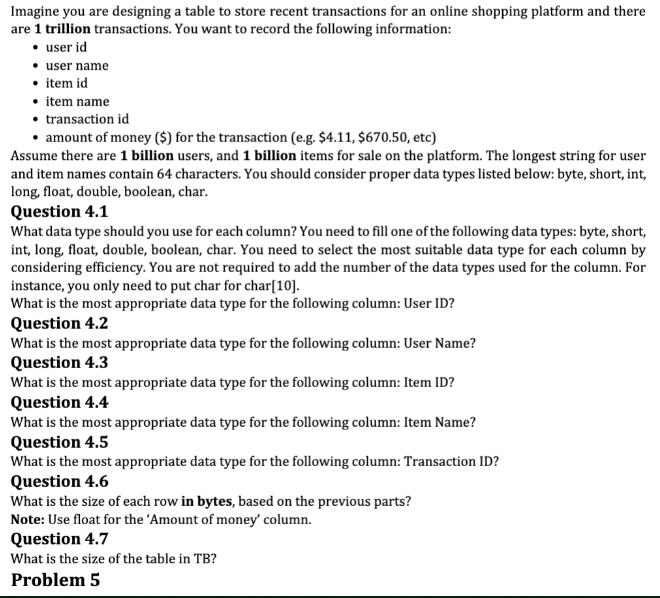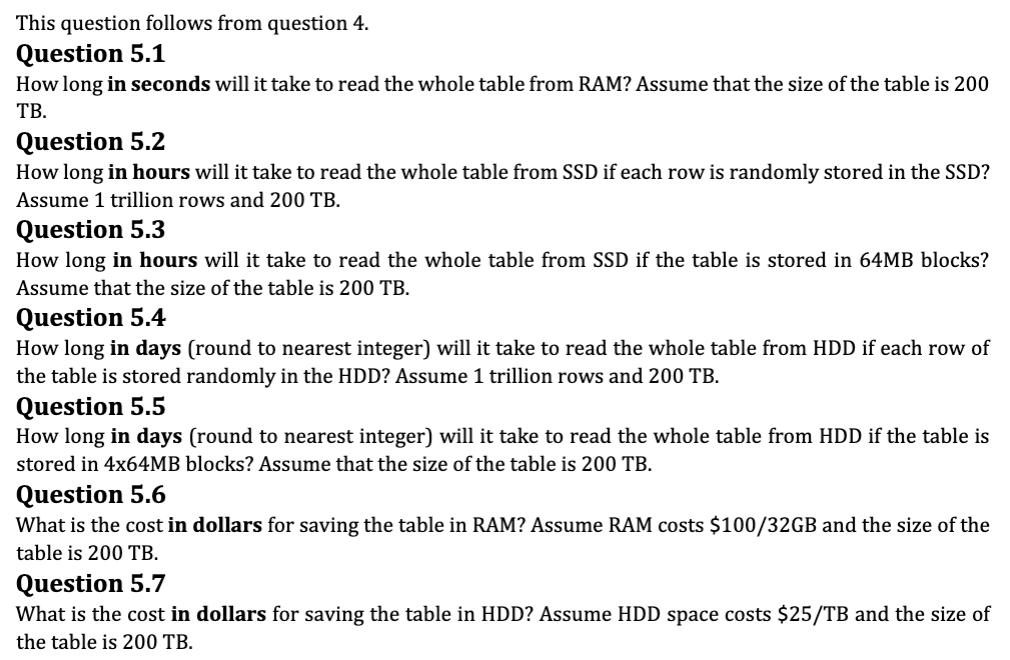Answered step by step
Verified Expert Solution
Question
1 Approved Answer
Imagine you are designing a table to store recent transactions for an online shopping platform and there are 1 trillion transactions. You want to


Imagine you are designing a table to store recent transactions for an online shopping platform and there are 1 trillion transactions. You want to record the following information: user id user name item id item name transaction id amount of money ($) for the transaction (e.g. $4.11, $670.50, etc) Assume there are 1 billion users, and 1 billion items for sale on the platform. The longest string for user and item names contain 64 characters. You should consider proper data types listed below: byte, short, int, long, float, double, boolean, char. Question 4.1 What data type should you use for each column? You need to fill one of the following data types: byte, short, int, long, float, double, boolean, char. You need to select the most suitable data type for each column by considering efficiency. You are not required to add the number of the data types used for the column. For instance, you only need to put char for char[10]. What is the most appropriate data type for the following column: User ID? Question 4.2 What is the most appropriate data type for the following column: User Name? Question 4.3 What is the most appropriate data type for the following column: Item ID? Question 4.4 What is the most appropriate data type for the following column: Item Name? Question 4.5 What is the most appropriate data type for the following column: Transaction ID? Question 4.6 What is the size of each row in bytes, based on the previous parts? Note: Use float for the 'Amount of money' column. Question 4.7 What is the size of the table in TB? Problem 5 This question follows from question 4. Question 5.1 How long in seconds will it take to read the whole table from RAM? Assume that the size of the table is 200 TB. Question 5.2 How long in hours will it take to read the whole table from SSD if each row is randomly stored in the SSD? Assume 1 trillion rows and 200 TB. Question 5.3 How long in hours will it take to read the whole table from SSD if the table is stored in 64MB blocks? Assume that the size of the table is 200 TB. Question 5.4 How long in days (round to nearest integer) will it take to read the whole table from HDD if each row of the table is stored randomly in the HDD? Assume 1 trillion rows and 200 TB. Question 5.5 How long in days (round to nearest integer) will it take to read the whole table from HDD if the table is stored in 4x64MB blocks? Assume that the size of the table is 200 TB. Question 5.6 What is the cost in dollars for saving the table in RAM? Assume RAM costs $100/32GB and the size of the table is 200 TB. Question 5.7 What is the cost in dollars for saving the table in HDD? Assume HDD space costs $25/TB and the size of the table is 200 TB. Imagine you are designing a table to store recent transactions for an online shopping platform and there are 1 trillion transactions. You want to record the following information: user id user name item id item name transaction id amount of money ($) for the transaction (e.g. $4.11, $670.50, etc) Assume there are 1 billion users, and 1 billion items for sale on the platform. The longest string for user and item names contain 64 characters. You should consider proper data types listed below: byte, short, int, long, float, double, boolean, char. Question 4.1 What data type should you use for each column? You need to fill one of the following data types: byte, short, int, long, float, double, boolean, char. You need to select the most suitable data type for each column by considering efficiency. You are not required to add the number of the data types used for the column. For instance, you only need to put char for char[10]. What is the most appropriate data type for the following column: User ID? Question 4.2 What is the most appropriate data type for the following column: User Name? Question 4.3 What is the most appropriate data type for the following column: Item ID? Question 4.4 What is the most appropriate data type for the following column: Item Name? Question 4.5 What is the most appropriate data type for the following column: Transaction ID? Question 4.6 What is the size of each row in bytes, based on the previous parts? Note: Use float for the 'Amount of money' column. Question 4.7 What is the size of the table in TB? Problem 5 This question follows from question 4. Question 5.1 How long in seconds will it take to read the whole table from RAM? Assume that the size of the table is 200 TB. Question 5.2 How long in hours will it take to read the whole table from SSD if each row is randomly stored in the SSD? Assume 1 trillion rows and 200 TB. Question 5.3 How long in hours will it take to read the whole table from SSD if the table is stored in 64MB blocks? Assume that the size of the table is 200 TB. Question 5.4 How long in days (round to nearest integer) will it take to read the whole table from HDD if each row of the table is stored randomly in the HDD? Assume 1 trillion rows and 200 TB. Question 5.5 How long in days (round to nearest integer) will it take to read the whole table from HDD if the table is stored in 4x64MB blocks? Assume that the size of the table is 200 TB. Question 5.6 What is the cost in dollars for saving the table in RAM? Assume RAM costs $100/32GB and the size of the table is 200 TB. Question 5.7 What is the cost in dollars for saving the table in HDD? Assume HDD space costs $25/TB and the size of the table is 200 TB. Imagine you are designing a table to store recent transactions for an online shopping platform and there are 1 trillion transactions. You want to record the following information: user id user name item id item name transaction id amount of money ($) for the transaction (e.g. $4.11, $670.50, etc) Assume there are 1 billion users, and 1 billion items for sale on the platform. The longest string for user and item names contain 64 characters. You should consider proper data types listed below: byte, short, int, long, float, double, boolean, char. Question 4.1 What data type should you use for each column? You need to fill one of the following data types: byte, short, int, long, float, double, boolean, char. You need to select the most suitable data type for each column by considering efficiency. You are not required to add the number of the data types used for the column. For instance, you only need to put char for char[10]. What is the most appropriate data type for the following column: User ID? Question 4.2 What is the most appropriate data type for the following column: User Name? Question 4.3 What is the most appropriate data type for the following column: Item ID? Question 4.4 What is the most appropriate data type for the following column: Item Name? Question 4.5 What is the most appropriate data type for the following column: Transaction ID? Question 4.6 What is the size of each row in bytes, based on the previous parts? Note: Use float for the 'Amount of money' column. Question 4.7 What is the size of the table in TB? Problem 5 This question follows from question 4. Question 5.1 How long in seconds will it take to read the whole table from RAM? Assume that the size of the table is 200 TB. Question 5.2 How long in hours will it take to read the whole table from SSD if each row is randomly stored in the SSD? Assume 1 trillion rows and 200 TB. Question 5.3 How long in hours will it take to read the whole table from SSD if the table is stored in 64MB blocks? Assume that the size of the table is 200 TB. Question 5.4 How long in days (round to nearest integer) will it take to read the whole table from HDD if each row of the table is stored randomly in the HDD? Assume 1 trillion rows and 200 TB. Question 5.5 How long in days (round to nearest integer) will it take to read the whole table from HDD if the table is stored in 4x64MB blocks? Assume that the size of the table is 200 TB. Question 5.6 What is the cost in dollars for saving the table in RAM? Assume RAM costs $100/32GB and the size of the table is 200 TB. Question 5.7 What is the cost in dollars for saving the table in HDD? Assume HDD space costs $25/TB and the size of the table is 200 TB.
Step by Step Solution
★★★★★
3.43 Rating (153 Votes )
There are 3 Steps involved in it
Step: 1
Lets analyze each column and determine the most appropriate data type for each one Question 41 User ID Number of users 1 billion Suitable data type int 4 bytes Explanation An int can easily accommodat...
Get Instant Access to Expert-Tailored Solutions
See step-by-step solutions with expert insights and AI powered tools for academic success
Step: 2

Step: 3

Ace Your Homework with AI
Get the answers you need in no time with our AI-driven, step-by-step assistance
Get Started


